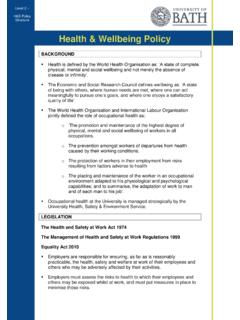Transcription of ‘Staying Put’ for young people in residential care: A ...
1 staying Put for young people in residential care : a scoping exercise December 2014 A report produced by a collaboration between the National Children s Bureau, The Who Cares? Trust, Action for Children, Barnardo s, Together Trust and the Centre for Child and Family Research, Loughborough University. Special thanks to young people and adult care leavers who took part in the consultation Stakeholder workshop participants Our workshop facilitator staying Put for young people in residential care : a scoping exercise 2 Executive Summary This report explores options for providing an equivalent of staying put for young people in residential care and the potential challenges and costs that will need to be taken into account for effective implementation.
2 The work was undertaken by a collaboration between the National Children s Bureau, The Who Cares? Trust, Action for Children, Barnardo s, Together Trust and Loughborough University, supported by seed funding from the Department for Education s Innovation Programme. scoping of four options A stakeholder workshop1 identified four different options for residential care staying put arrangements which formed the basis of consultation with young people and the costings work. Below are the brief descriptions used in the consultation with young people .
3 More detail is included in the full report. Option One: care leavers live in the same children s home that they were living in when they were in care . They can stay there until they are 21. Option Two: care leavers live in a separate building but in the same grounds as the children s home that they were living in when they were in care . They can stay there until they are 21. Option Three: This option is like supported lodgings. care leavers live in a different house to where they were living when they were in their children s home.
4 young people have to be 16-years-old or older to live here and will have to move from where they are living if they want to stay put until they are 21. Not everyone who lives there might be from care . Option Four: care leavers stay close . They live independently in their own flat. It s down the road, or very close to the children s home they were living in when they left care . They have a key worker from their children s home who they know really well to help them with support. They can visit their children s home if they want for example visiting for tea.
5 Feedback from young people and adult care leavers Children in care and young and adult care leavers were consulted over a four week period about their views on staying put in residential care and the four suggested options. There was a general consensus that staying put should, in some form, be extended to children who are living in children s homes The consultation also highlighted the importance of each young person having a choice about what happens to them when they turn 18, with young people they consistently talking about no one option being right for everyone, and the importance of being allowed to make a choice.
6 They also gave suggestions as to the type of support that care leavers would need, and how it should be provided. For instance, young people were very clear that there should be support available at all times, not just during working hours. Other key themes emerged in the analysis of the consultation, support and care , 1 The facilitated workshop held in October 2014 was attended by 18 stakeholders and sector experts including local authority representatives; residential care home provider representatives and representatives from the voluntary sector.
7 staying Put for young people in residential care : a scoping exercise 3 relationships and stability, responsibility and independence, the age of those living in the children s home (either children in care with care leavers or 16 and 17 year olds) loneliness. Reccomendation: young people leaving residential care are offered consistent support towards independence, in a setting that best meets their needs and preferences based on meaningful consultation with the young person. Costings Four hypothetical, illustrative case studies have been created to show the pathway of a young person accessing each of the four different options.
8 The services, support and associated costs that are estimated are based on an optimum level of service for this vulnerable cohort of young people . A fifth hypothetical case study has also been included in this paper to illustrate an alternative journey for a young person between the ages of 18 and 21, depicting a probable journey for a young person moving on from residential care at age 18 without any of the proposed staying Put options. A preliminary exercise has been carried out to tentatively explore the national cost implications of extending staying Put to young people in residential provision, with a proportion of the residential care population taking up each of the four options.
9 These should be treated with caution for the numerous reasons outlined in the full report. Proportion of young people (%) Frequency Cost per young person (for three years) Total cost per Option Option 1 (25%) 288 493,296 141,995,994 Option 2 (13%) 150 323,535 48,427,618 Option 3 (17%) 196 141,908 27,776,933 Option 4 (25%) 288 33,828 9,737,441 Totals (3 years) 921 227,937,985 Totals (1 year) 921 75,979,328 Recommendation: the costings in this paper are used only as an indication of how much investment may be needed and that further detailed work is undertaken to inform potential allocations to local authorities.
10 Practical and regulatory barriers To secure a consistent offer for young people there would need to be a new dity placed on local authorities. The duty must be sufficiently strong to ensure that all local authorities are in no doubt of their responsibility to commission the requisite accommodation and support, and sufficiently broad to support the offer of a range of options, in line with those set out in this report. It must reflect the fact this will not necessarily be based on an arrangement between a young person and the existing provider of care and accommodation (as in foster care staying put arrangements).


















